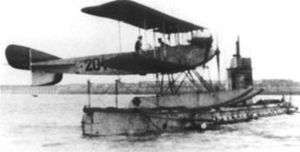Friedrichshafen FF.29
The Friedrichshafen FF.29 was a German lightweight two-seat floatplane of the 1910s produced by Flugzeugbau Friedrichshafen.
| FF.29 | |
|---|---|
 | |
| U-12 with FF.29 on deck | |
| Role | Two-seat coastal patrol floatplane |
| Manufacturer | Flugzeugbau Friedrichshafen |
| First flight | 1910s |
| Introduction | 1914 |
| Primary user | German Imperial Navy |
| Number built | 44 |
Development and design
The FF.29 was designed as a lightweight floatplane, a biplane powered by a Mercedes D.II inline piston engine. Five FF.29s were built at the Orlogsværftet Flyvemaskineværksted in Denmark, designated Orlogsværftet HB.I
Operational history
The FF.29 entered service with the German Imperial Navy in November 1914, it was used for coastal patrol and reconnaissance and had the ability to carry a small load of bombs. On 24 December 1914 an FF.29 was the first aircraft to drop a bomb on British soil, a single bomb landed in the garden of a house in Leyburn Road, Dover. There were no injuries and little damage beyond a crater in the lawn and smashed windows. On 15 January 1915 a FF.29 was the first plane to be launched from a submarine, the SM U-12.
Variants
- FF.29
- Production aircraft.
- FF.29A
- A similar aircraft with improved floats and tail surfaces.
Operators
- German Imperial Navy
Specifications (FF.29)
General characteristics
- Length: 10.40 m (34 ft 1 in)
- Wingspan: 16.30 m (53 ft 6 in)
- Wing area: 57.5 m2 (619 sq ft)
- Empty weight: 928 kg (2,046 lb)
- Gross weight: 1,400 kg (3,086 lb)
- Powerplant: 1 × Mercedes D.II , 90 kW (120 hp)
Performance
See also
Related lists
Further reading
- The Illustrated Encyclopedia of Aircraft (Part Work 1982–1985). Orbis Publishing.
- Borzutzki, Siegfried (1993). Flugzeugbau Friedrichshafen GmbH: Diplom-Ingenieur Theodor Kober. Berlin: Königswinter. p. 102.